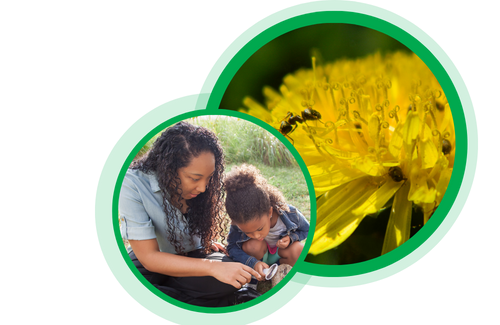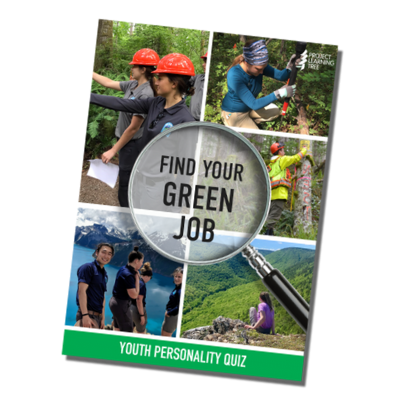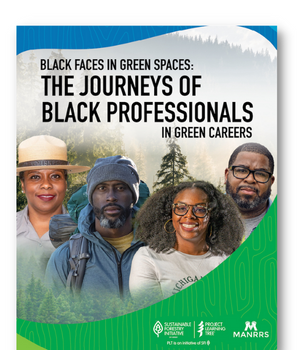Are you new to teaching or new to teaching about the environment? Project Learning Tree is here to help!
Not only does PLT provide easy-to-teach, hands-on activities suitable for a variety of settings—PLT also offers a range of resources to support and mentor new environmental educators.
January is National Mentoring Month, a time to recognize the importance of mentoring and the impact it can have. For new educators, drawing on others’ wisdom and experience helps lead to more successful and rewarding teaching. PLT’s cadre of State Coordinators serve as mentors to educators in their state by providing ideas and tips for incorporating environmental education and outdoor learning into their teaching.
Getting Started
A good place to start is with one of PLT’s fun, flexible, student-centered activities that invite students to explore the world around them. With step-by-step directions, background information, academic standards, and student pages, PLT activity guides can save you time—and make teaching easier.
Get started with a list of sample activities from PLT’s Trees & Me: Activities for Exploring Nature with Young Children, Explore Your Environment: K-8 Activity Guide, and more.

In addition to a whole suite of activity guides, PLT has a highly engaged and geographically diverse network of educators with an enormous collective wealth of knowledge and expertise that can provide support and encouragement on your teaching journey. This network allows you to connect with others in your area to ask questions and share resources, providing informal mentoring to new educators.
PLT also offers in-person and online trainings to help strengthen teaching skills and enhance student learning. Educators often rate PLT trainings as the best professional development experiences.
For information about these and other PLT resources and events, your State Coordinators are always happy to answer your questions and to help you connect to mentor teachers in your area.
 PLT Activities for New Environmental Educators
PLT Activities for New Environmental Educators
All PLT activities are tested and proven effective. The following work well with many learners and settings – and practically teach themselves!
For Grades K-2:
Use these activities from PLT’s Explore Your Environment: K-8 Activity Guide to get started teaching students:
- Have Seeds, Will Travel – Students learn about plant reproduction and seed dispersal by observing, collecting, and classifying seeds. This STEM activity can be done either inside or outside the classroom. See Explore Your Environment for details.
- The Closer You Look – In this art-based activity, students draw a tree from memory and compare it to their observations of a real tree, helping them to identify characteristics of tree parts.
- Trees as Habitats – Students make “telescopes” out of paper tubes to help them observe a tree, and then play a game of Bingo to look for signs of plants and animals living in or around it.
Use these activities from PLT’s Trees & Me: Activities for Exploring Nature with Young Children to get started teaching young children ages 1-6:
- The Shape of Things — Children search for the shapes and colors that define both our natural and built environments.
- Sounds Around — Children explore the sounds of nature and imitate them using their voices and instruments that they make together.
- Home Tweet Home — Children discover how plants and animals depend on trees.

For Grades 3-5
Use these activities from PLT’s Explore Your Environment: K-8 Activity Guide to get started teaching students:
- Discover Diversity – Students imagine they are visitors from outer space, viewing life on Earth for the first time. They describe all the living things they find in a small outdoor plot and become more aware of the abundance and diversity of life.
- Poet-Tree – After observing nearby trees, students create and share poetry to express their thoughts, feelings, and beliefs about trees and forests.
- Web of Life – Students research forest plants and animals to learn what they eat and what eats them, and then use a ball of yarn to model a food web and show how the species are connected.
For Grades 6-8
Use these activities from PLT’s Explore Your Environment: K-8 Activity Guide to get started teaching students:
- Field, Forest, and Stream – Students conduct a field study of three different ecosystems to learn about their similarities and differences.
- Nature’s Skyscrapers – In this math-based activity, students measure a tree’s height, girth, and crown spread, and compare their findings to the largest known living tree in the world.
For Secondary and Post-Secondary
- Who Works In this Forest? – Students are introduced to different forest sector careers and research to learn what it takes to perform these jobs. Explore PLT’s Green Jobs: Exploring Forest Careers guide to learn more.
- Monitoring Forest Health – Students conduct a forest health checkup of a local forest area to learn about the ecological services forests provide. While seven forest health indicators are provided, you may focus on just one to start. Explore PLT’s Green Jobs: Exploring Forest Careers guide to learn more.
- PLT Green Jobs Quiz – Students can take a quiz to learn about their personality and some green job opportunities that might suit them best. Take PLT’s Green Jobs Quiz.
- PLT’s Forest Literacy Framework – PLT’s Forest Literacy Framework translates the language of forests and sustainable forest management into concepts for everyone at any age. The framework offers 100 forest concepts for grades K-12, organized into four themes.
Advice for Bringing Classes Outdoors
Exploring the outdoors is invaluable for learners as it expands understanding and deepens connections to the natural world. Time outside strengthens not only academic learning, but also promotes mental, social, and physical health.
That said, many new environmental educators are daunted by the idea of taking students outside to learn. Here are some tips from Lena Ives, PLT Maine Coordinator, and Michelle Youngquist, PLT Idaho Coordinator:
- Think of the outdoors as simply an extension of indoor teaching spaces.
- Your biggest goal should be a positive experience.
- Start small.
- Practice skills with students inside before doing them outdoors.
- Don’t be afraid to adapt the lesson as go.
- Remember that you don’t have to know all the answers.
- Tap into local resources: get a fellow teacher or resource professional to help with your first excursions.
- Enlist students to help with class management (helping identify boundaries, manage equipment and timing, report questions to the teacher, and so on).
- Take along a tote with cut-up pieces of old yoga mats or camping pads to sit or kneel on when the ground is wet, cold, or pokey.

Mentoring the Next Generation
Mentoring creates opportunities to share tips and resources, transfer skills, and boost the confidence of mentees and mentors alike! Mentorship enables educators and forestry professionals to be more engaged and more effective.
PLT is committed to supporting and mentoring the next generation of environmental educators and forestry professionals through free programs and green career pathway resources, including:
- Green Jobs Quiz – Students discover green jobs best suited to their personality through this online quiz. Sign up for a free trial at PLT.org/GreenJobsQuiz.
- Green Jobs: Exploring Forest Careers –This guide is the perfect tool to help young people ages 12-25 learn about green jobs in forestry and natural resource management. It can be used in a range of settings, from community youth programs and school classrooms to college and career prep. Explore forest careers.
- The Journeys of Black Professionals in Green Jobs – A recent U.S. Census Survey indicates that less than 3% of foresters and conservation scientists identify as African American. This new guide can help young Black Americans discover opportunities for rewarding careers in forestry and conservation. Learn more at plt.org/journeys.
- PLT Green Mentor Program –This program connects young people ages 18-30 with forest professionals across Canada and the United States to build their forest and conservation knowledge and career goals—and gain new perspectives. Learn more at plt.org/mentorship.





